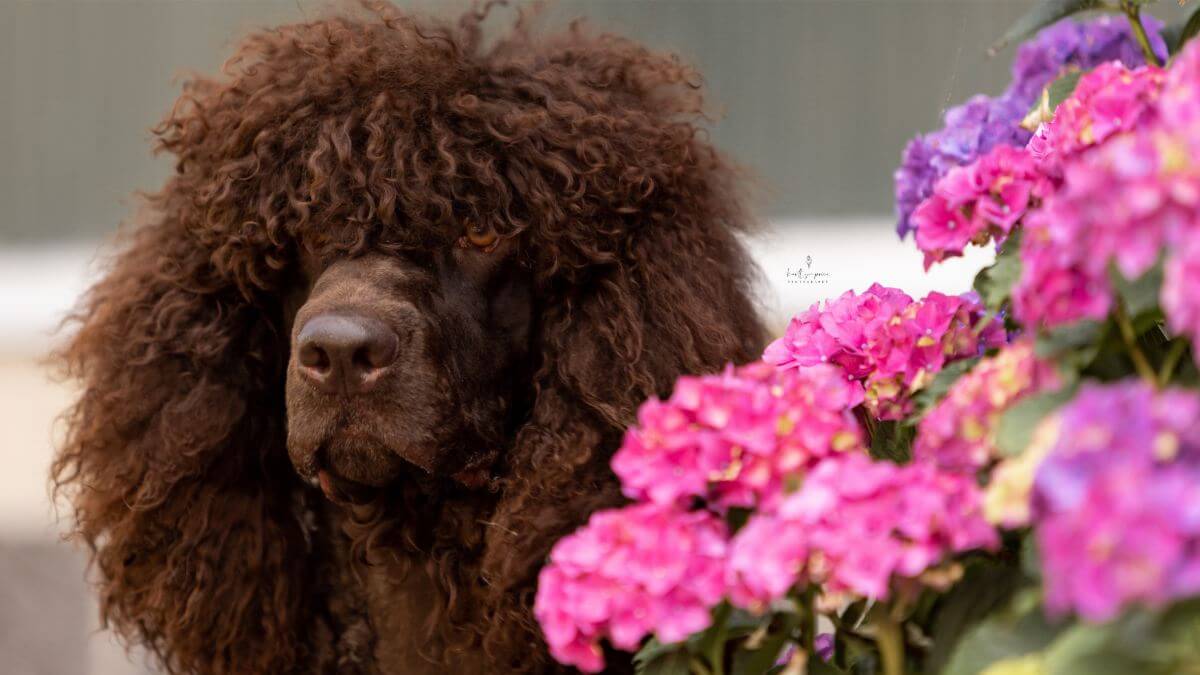
Home » Judging the Irish Water Spaniel

This article was originally published in Showsight Magazine, January 2013 issue.
As the class enters the ring, my mind goes to the first part of the standard. I am looking for a “smart, upstanding, strongly built moderate gundog” that must have the distinguishing characteristics of this breed: “a topknot of long, loose curls and body covered with a dense, crisply curled liver-colored coat contrasted by a smooth face and a smooth ‘rat’ tail.” This is breed “type.”
The standard goes on to say, “A well-balanced dog that should not appear leggy or coarse,” and “strongly built and well-boned.” This is the image that is in my head while I am getting my first impression of the dogs in the class.
The next thing I want to see is a flowing and balanced side-gait as I take the class around for the first time. The standard clearly says, “Moves freely and soundly with balanced reach and drive.”
It is now time to start the individual exams. ALWAYS approach an Irish Water Spaniel from the front and without hesitation, but with respect. The standard states, “May be reserved with strangers.” It does not mean there should ever be any aggression. The standard further states they are “very alert, inquisitive, and active.” If you act unsure, they will pick up on it and may back away. I never talk to the dog as I first approach it. It is better if I have something I want to say to talk to the handler and not directly to the dog. And if I do say anything, it is done in a normal conversational voice. Most IWS will be more relaxed if they observe the people around them acting “normal.”
The first thing I want to see is a head that stays true to the standard but matches the dog. Extremes of either overly coarse or overly snipy are not correct. This is a dog that should be able to handle many types of birds with ease. The standard calls for a muzzle that is “long, deep and somewhat square in appearance.” It goes on to say, “with a strong underjaw,” again noting the need to be able to manage a bird of decent size.
They say the eyes are the window to the soul. A proper eye makes the expression in the IWS. The standard says, “The expression is keenly alert, intelligent, direct and quizzical.” And the color should be warm shades of brown to dark amber to aid the expression. And as they are a breed that both beats the bush and retrieves from the water, the standard says, “Set almost flush, the eyes are comparatively small and almond-shaped with tight eyelids.”
When checking the bite, remember that the standard does say “scissor or level.”
Next, I examine the coat, starting with the unique breed characteristic topknot. This should be long, loose curls that fall over the ears. And this is also the time to examine the ears to see that they are “long, lobular, set low,” and also covered with “long loose curls of hair.”
As I move on to the shoulders, I should see a transition in coat to the basic body coat, which should be “covered with dense, tight, crisp curls.”
I continue on to determine if the forequarters have proper slope of the shoulders, moderately laid back but clean and powerful. The standard says, “The entire front gives the impression of strength without heaviness.”
Next, I am looking for well-sprung ribs “as to give a barrel shape.” I move on to determine if the “loin is short, wide, muscular and deep so it does not give a tucked-up appearance.”
As I arrive at the hindquarters, it again is important to think of the standard. “Sound hindquarters are of great importance to provide drive and power while swimming. They are as high as or slightly higher than the shoulders, with powerful, muscular, well-developed thighs. The hips are wide. The croup is rounded and full with the tail set on low enough to give a rounded appearance. The stifles are moderately bent. Hocks are set low and moderately bent.”
And finally, the tail. The “Rat-Tail” is a breed characteristic. The dense curls should continue from the body onto the first two to three inches of the base of the tail. From there to the tip, the coat should be smooth. The tail is thick at the base and tapers as you get to the tip.
It is now time to move the dog on the common down and back. The standard says the gait “should be true, precise and not slurring.” But this breed can have a “characteristic rolling motion accentuated by the barrel-shaped rib cage.”
After examining the dogs individually, moving them on the down and back and around, I will once again take the class around together as I make my final determination of placements. I am taking that last look with the desire to make sure I have found the best of the sportsman’s dogs. The dog that could go out and work all day if necessary, covering ground with balance and minimal effort that can only be found in a well-balanced, well-conditioned, and properly structured sporting dog. A “strongly built moderate gundog.”